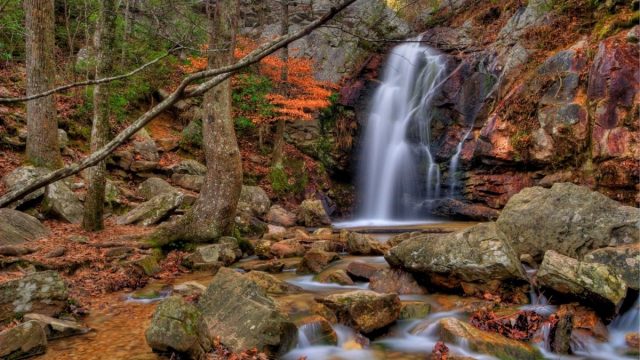
Many folks may not view parks and nature trails as pivotal tools for economic development. But a recent report prepared for the Alabama Innovation Commission hails Alabama’s abundant natural resources as a potential magnet for making the state more attractive for drawing advanced industries, and attracting the skilled workforce those businesses need.
According to the report by the prestigious Hoover Institution at Stanford University, “Alabama is exceptionally endowed with a vast array of natural assets that can be leveraged to expand its outdoor recreation industry, enhancing the state’s attractiveness for high-skill individuals and new tourists, as well as yielding substantial returns for both rural and urban communities.”
On the other hand, “… many natural assets remain underdeveloped within Alabama, holding the state back from realizing its full potential to draw high-skill workers and to establish itself as an outdoor recreation powerhouse within the southeastern region of the United States,” the report states.
This coming spring, Alabamians will decide whether to invest more in some of the state’s natural assets. A constitutional amendment, scheduled for statewide vote in May, would clear the way for Alabama to issue up to $80 million in bonds for maintenance, improvements and acquisitions related to the state parks system. Another $5 million would support historical sites management by the Alabama Historical Commission.
Gov. Kay Ivey supports the bond measure, which was cleared for a public vote earlier this year by the Alabama Legislature. “Alabamians love and cherish the state parks, and we must make sure they are maintained and available for generations to come,” Ivey said during an event last April touting the bond issue.
The Hoover Institution report, released late last month, examined how Alabama can better nurture and develop a technology-based, innovation economy. The 156-page report offered recommendations on several fronts, including: the role Alabama universities can play in fostering innovation and growth; supporting advanced manufacturing; broadband expansion; and tax policies.
The report also took a close look at the state’s extraordinary natural resources, from its many rivers and streams, to the Gulf beaches, to its mountains, to its outstanding biodiversity. Providing greater public access to natural assets, and more facilities to enjoy outdoor recreation, from hiking to kayaking, the report said, is not only a vital component for drawing high-tech industries and the educated workforce they demand; it is also a driver for creating local businesses and a stronger economy around outdoor sports and activities.
“A substantial, coordinated and long-term program of investment in outdoor recreation infrastructure will yield substantial returns to the state. Some of those returns will be direct, in the form of dollars spent by out-of-state tourists,” the report states. Some of the returns will be indirect, the report noted, by boosting the state’s ability to recruit and retain the workforce needed to create innovative businesses and industries. Some of the returns will benefit rural areas, as demand increases “… for outfitters, guide services, hotels, restaurants, and the like, by high-skill workers in innovative industries.” Urban areas, too, will benefit, the report concluded, by increasing “demand for housing, restaurants, cafes and the like along new (or expanded) urban walking trails, bikeways and blueways.”
The report recommends creating a joint commission that would support expanding the “supply of outdoor infrastructure throughout the state,” working with the Alabama Department of Conservation and Natural Resources, cities and counties, nonprofit organizations and others to craft an outdoor recreation master plan for Alabama.
“When all the different metrics are taken together, a consistent picture emerges: There is plentiful room for investment and potential for growth in Alabama’s outdoor recreation industry,” the report states.
Alabama lagging neighbors in outdoor assets
According to data compiled by the Hoover Institution, Alabama trails its neighboring states in investing in and reaping the economic benefits of its natural assets, even after accounting for size and population differences. Some of the numbers:
- Mississippi dedicates about 1.5 times more of its land to publicly accessible recreation than Alabama, Georgia twice as much, Tennessee three times as much and Florida close to five times as much.
- According to information from the online hiking site AllTrails, Alabama lags in trail development with 721 trails registered, compared with Georgia’s 1,301, Tennessee’s 1,529 and Florida’s 1,899. Alabama surpasses only Mississippi, which has 185 trails listed.
- Publicly accessible lands account for only 6.2% of Alabama’s land area, compared to 10.5% in Mississippi, 13.4% in Georgia, 17.3% in Tennessee and 33% in Florida.
- Alabama is at the lower end of the scale when it comes to employment generated by outdoor recreation, with 62,687 jobs. That’s better than Mississippi at 33,592 jobs but well behind Tennessee with 106,012 jobs, Georgia with 143,122 jobs and Florida with 511,100 jobs.
- Low levels of job creation translate into lower levels of total compensation from outdoor recreation, the report said. Compensation from outdoor recreation in Alabama totals about $2 billion – higher than Mississippi’s $1.1 billion but way behind Tennessee at $4.1 billion, Georgia at $6.3 billion and Florida at $23.4 billion.
In addition to the state parks bond issue, the report states that the pending infrastructure bill in Congress offers an opportunity, if approved, to tap federal resources to expand and improve the state’s natural and outdoor assets.
“Alabama has a vast endowment of natural assets that can be leveraged to expand its outdoor recreation industry, enhancing the state’s attractiveness for high-skill individuals and new tourists, and yielding substantial returns to rural and urban communities,” the report concludes. “To develop these natural assets, the state needs to ramp up spending on its outdoor recreation infrastructure, particularly on projects that create externalities by attracting tourists, both within the state and from other states. Funding may come from combining private philanthropy, state funds, federal funds and revenue from users of the infrastructure.”
Read the full Hoover Institution report here.










